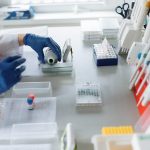What is Guided Tissue Regeneration (GTR)?
Guided tissue regeneration (GTR) is a dental technique employed to regenerate lost periodontal structures through differential tissue responses. It aims to reconstruct periodontal attachment by inhibiting epithelial cell growth, creating space for new bone and tissue formation.
What is Guided Tissue Regeneration (GTR)?
Definition of Guided Tissue Regeneration
Guided Tissue Regeneration (GTR) is a specialized dental procedure focused on regenerating lost periodontal tissues. The American Academy of Periodontology defines GTR as a procedure that attempts to regenerate lost periodontal structures. This involves selective cell and tissue repopulation within a periodontal ligament tissue wound. The primary goal of GTR is to achieve new attachment by removing bacterial infection and stimulating the regrowth of healthy bone and gum tissue, providing more support and stability for teeth.
The Glossary of Periodontal Terms includes Guided Bone Regeneration (GBR) in its definition. GTR employs barriers, often membranes, to exclude epithelial and connective tissue cells from the root surface, promoting the regeneration of periodontal ligament structures. This technique is used in periodontal surgery, oral surgery, and implant dentistry. Success of GTR depends on adequate infection control, and should not be pursued if the tooth has Millers class 2 or 3 mobility.
What is Guided Tissue Regeneration (GTR)?
Historical Context and Development of GTR
The development of Guided Tissue Regeneration (GTR) stems from the biological principle of regenerating periodontal tissues lost due to periodontal disease. The concept emerged from the understanding that different cell types have varying potentials for repopulating a wound site. Early efforts focused on preventing epithelial cells, which heal quickly but do not contribute to regeneration, from migrating into the defect area. By excluding these cells, GTR aimed to allow cells from the periodontal ligament and bone, which are responsible for regeneration, to populate the space.
The 1996 World Workshop in Periodontics formally defined GTR, solidifying its place in periodontal therapy. This definition highlighted the use of barrier membranes to create a protected space for tissue regeneration. Over time, GTR techniques have evolved, with advancements in membrane materials and surgical approaches. The evolution of GTR reflects a continuous effort to improve predictability and outcomes in periodontal regeneration.
The core principle of GTR lies in selectively promoting cell repopulation to regenerate lost periodontal structures. This is achieved by excluding unwanted cells, like epithelium, and favoring cells from periodontal ligament and bone for optimal healing.
Biological Rationale Behind GTR
The biological rationale behind Guided Tissue Regeneration (GTR) centers on the concept of selective cell repopulation. Following periodontal surgery, various cell types compete to populate the wound area. Epithelial cells, if allowed to migrate rapidly, can interfere with the regeneration of desired periodontal tissues like bone, cementum, and periodontal ligament.
GTR employs barrier membranes to physically exclude these rapidly migrating epithelial cells from the root surface. This creates a protected space where cells from the periodontal ligament and alveolar bone can proliferate and differentiate, leading to the regeneration of lost attachment. The membrane acts as a scaffold, guiding the tissue regeneration process.
By preventing epithelial downgrowth and promoting the repopulation of periodontal progenitor cells, GTR aims to restore the functional attachment apparatus of the tooth, resulting in improved stability and long-term periodontal health. Essentially, GTR manipulates the wound healing process to favor regeneration over repair.
Principles of Guided Tissue Regeneration
Selective Cell Repopulation in GTR
Selective cell repopulation is the cornerstone of Guided Tissue Regeneration (GTR). The principle revolves around controlling which cells populate the healing wound site after periodontal surgery. The goal is to favor cells with regenerative potential, specifically those from the periodontal ligament, cementum, and alveolar bone, while excluding less desirable cells, primarily epithelial cells.
Epithelial cells, known for their rapid migration, can quickly occupy the wound area, forming a long junctional epithelium instead of regenerating the lost periodontal attachment. GTR utilizes barrier membranes to physically prevent these epithelial cells from accessing the root surface during the critical healing phase.
By creating a protected space, the membrane allows slower-migrating, but more functionally important, cells from the periodontal ligament and bone to proliferate and differentiate. These cells can then contribute to the formation of new cementum, periodontal ligament fibers, and alveolar bone, effectively restoring the lost periodontal structures. This selective approach is crucial for achieving true periodontal regeneration.
Membrane Types in GTR (Resorbable vs. Non-Resorbable)
GTR utilizes membranes to exclude unwanted cells. These membranes are either resorbable, gradually dissolving, or non-resorbable, requiring removal. Each type offers distinct advantages based on the clinical situation and desired healing outcome.
Membrane Types in GTR (Resorbable vs. Non-Resorbable)
In guided tissue regeneration (GTR), membranes play a crucial role in creating a protected space for tissue regeneration. These membranes are broadly categorized into resorbable and non-resorbable types, each possessing distinct characteristics that influence their clinical application.
Resorbable membranes offer the advantage of eliminating the need for a second surgical procedure for removal. They are typically made from materials like collagen, synthetic polymers, or calcium sulfate. The resorption rate varies depending on the material composition, allowing clinicians to select membranes with degradation timelines that align with the desired healing period. While convenient, their structural integrity may diminish over time, potentially compromising barrier function.
Non-resorbable membranes, often constructed from materials such as titanium-reinforced polymers or expanded polytetrafluoroethylene (ePTFE), provide a more stable and predictable barrier. Their robust structure ensures sustained protection of the regenerating tissues. However, a second surgery is required for their removal, adding to the overall treatment time and cost. The choice between resorbable and non-resorbable membranes depends on factors such as defect morphology, desired space maintenance, and patient-specific considerations.
GTR Techniques and Procedures
Surgical Procedure Overview
The surgical procedure for guided tissue regeneration (GTR) involves meticulous steps to promote predictable tissue regeneration. Initially, thorough debridement of the defect site is performed to eliminate bacterial infection and inflammatory tissues. This step is crucial for creating a clean and conducive environment for healing.
Following debridement, the root surfaces are often planed to remove any remaining calculus or contaminants. The GTR membrane, selected based on the defect characteristics and desired outcome, is then carefully positioned to cover the defect and extend beyond the margins of the bony walls. This ensures complete exclusion of epithelial cells, allowing slower-growing periodontal ligament cells to repopulate the area.
The membrane is secured in place using sutures or tacks, preventing displacement during the healing phase. Finally, the surgical site is meticulously closed with sutures to achieve primary closure and protect the membrane. Post-operative care includes meticulous oral hygiene instructions and potential antibiotic therapy to minimize the risk of infection. A follow-up is necessary to remove non-resorbable membranes.
Applications of GTR in Dentistry
Guided tissue regeneration (GTR) is used in dentistry for periodontal surgery, implant dentistry, and oral surgery. It aims to stimulate regrowth of healthy bone and gum tissue, repairing periodontal defects for tooth stability.
Periodontal Surgery Applications
In periodontal surgery, guided tissue regeneration (GTR) is a valuable technique for addressing tissue loss due to periodontal disease. The primary goal is to regenerate lost periodontal structures, such as bone and connective tissue, that support the teeth. GTR procedures are often employed to treat intrabony defects, furcation involvements, and recession defects, aiming to restore the attachment apparatus and improve the long-term prognosis of compromised teeth.
By utilizing barrier membranes, GTR prevents the ingrowth of unwanted epithelial cells, allowing slower-growing cells from the periodontal ligament and bone to populate the defect area. This selective cell repopulation promotes the formation of new cementum, periodontal ligament, and alveolar bone, leading to improved periodontal health and stability. Successful GTR in periodontal surgery can result in reduced pocket depths, increased clinical attachment levels, and enhanced bone fill, ultimately contributing to the preservation of the natural dentition and improved patient outcomes. The procedure enhances tooth support and stability.
Implant Dentistry Applications
In implant dentistry, guided tissue regeneration (GTR), often referred to as guided bone regeneration (GBR) in this context, plays a crucial role in creating an optimal environment for implant placement and osseointegration. GBR is frequently employed to augment deficient alveolar ridges, addressing bone loss resulting from tooth extraction, trauma, or periodontal disease. This ensures adequate bone volume and density to support dental implants, enhancing their long-term stability and success.
GBR procedures in implant dentistry involve the use of barrier membranes to exclude soft tissue cells from the bone defect area, allowing bone-forming cells to populate the space and regenerate new bone. This technique is particularly useful in cases where there is insufficient bone height or width for implant placement. By creating a suitable foundation, GBR improves implant stability, esthetics, and function, ultimately leading to more predictable and successful implant outcomes. It enhances the chances of successful osseointegration.
Factors Affecting GTR Success
GTR success hinges on several factors, including proper patient selection, meticulous surgical technique, and effective infection control. Moreover, achieving predictable outcomes requires careful consideration of membrane type and stability during healing.
Patient Selection and Considerations
Successful Guided Tissue Regeneration (GTR) relies heavily on appropriate patient selection. Patients with Miller’s class 2 or 3 mobility may not be suitable candidates. Pre-operative assessment must consider systemic health, smoking habits, and oral hygiene. Uncontrolled diabetes or heavy smoking can significantly impair healing and compromise GTR outcomes.
Furthermore, patient compliance with post-operative instructions is crucial. Meticulous oral hygiene practices, including gentle brushing and interdental cleaning, are essential to prevent infection and promote tissue regeneration. Patients must understand the importance of attending follow-up appointments for monitoring and professional cleaning.
The severity and type of periodontal defect also influence patient selection. GTR is generally more predictable in treating intrabony defects than horizontal bone loss. Careful evaluation of radiographic and clinical parameters is necessary to determine the feasibility of GTR and to set realistic expectations for treatment outcomes. Patient motivation and commitment to long-term maintenance are key determinants of success.
Importance of Infection Control
Infection control is paramount to the success of Guided Tissue Regeneration (GTR). Bacterial infection can impede tissue regeneration and lead to treatment failure. Pre-operative measures include thorough scaling and root planing to reduce the bacterial load in the surgical site. The use of antimicrobial mouth rinses, such as chlorhexidine, is also recommended to further minimize infection risk.
During the surgical procedure, strict aseptic techniques must be followed. This includes using sterile instruments, wearing appropriate personal protective equipment, and maintaining a sterile field. Post-operative infection control is equally important. Patients should be instructed on proper oral hygiene practices and may be prescribed antibiotics to prevent or treat any infection.
Regular monitoring of the surgical site is necessary to detect early signs of infection, such as redness, swelling, or pus formation. Prompt intervention with appropriate antibiotics and debridement can help to resolve the infection and salvage the GTR procedure. Ultimately, meticulous infection control protocols are essential for predictable and successful GTR outcomes.

